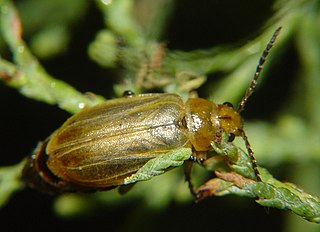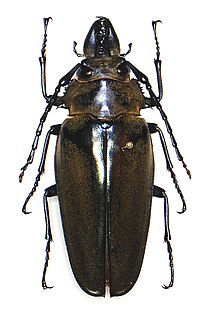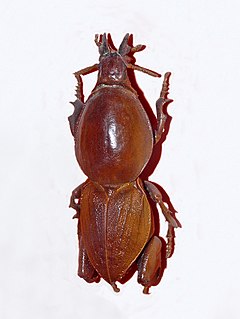
The longhorn beetles (Cerambycidae), also known as long-horned or longicorns, are a large family of beetles, with over 35,000 species described. Most species are characterized by extremely long antennae, which are often as long as or longer than the beetle's body. In various members of the family, however, the antennae are quite short and such species can be difficult to distinguish from related beetle families such as the Chrysomelidae. The scientific name of this beetle family goes back to a figure from Greek mythology: after an argument with nymphs, the shepherd Cerambus was transformed into a large beetle with horns.

Endopterygota, also known as Holometabola, is a superorder of insects within the infraclass Neoptera that go through distinctive larval, pupal, and adult stages. They undergo a radical metamorphosis, with the larval and adult stages differing considerably in their structure and behaviour. This is called holometabolism, or complete metamorphism.

The flea beetle is a small, jumping beetle of the leaf beetle family (Chrysomelidae), that makes up the tribe Alticini which is part of the subfamily Galerucinae. Historically the flea beetles were classified as their own subfamily.
Jean Baptiste Lucien Buquet was a French entomologist and insect dealer mainly interested in Coleoptera. He described many new genera and species. Buquet's business dealt in exotic Coleoptera, especially Buprestidae, Lucanidae, Scarabaeidae and Cerambycidae. He also sold Lepidoptera, especially Morpho and Agrias. The insects came mainly from the French colonial empires. He was a member of the Société entomologique de France

Auguste Alfred Lucien Gaston Lameere was a Belgian entomologist. He made several collecting expeditions to the Algerian Sahara region.

Spondylidinae are a small subfamily of Cerambycidae including slightly over 100 species, primarily in the coniferous forests of the Boreal hemisphere. A few species occur in coniferous forests in tropical and subtropical areas, while very few genera are present in Austral Africa and Madagascar.

The Disteniidae are a small family of beetles in the superfamily Chrysomeloidea, traditionally treated as a group within the Cerambycidae.

The Oxypeltidae are a small family belonging to the superfamily Chrysomeloidea, widespread in the Andean region of Chile and Argentina. They have traditionally been considered a group within the Cerambycidae.

Diorhabda elongata is a species of leaf beetle known as the Mediterranean tamarisk beetle (MTB) which feeds on tamarisk trees from Portugal and Algeria east to southern Russia. The MTB is used in North America as a biological pest control agent against saltcedar or tamarisk, an invasive species in arid and semi-arid ecosystems.

The Trictenotomidae are a small family of beetles in the suborder Polyphaga containing fifteen species in two genera. Most species are found in the Oriental realm where they live in montane forest habitats. The family is considered, based on larval characters as well as sequence-based studies, to be closely related to the Salpingidae.

Cerocoma is a Palearctic genus of blister beetle, whose biology is poorly known. As in other members of the family, these insects are hypermetamorphic. Larval hosts of few species were described. Imagines show distinct sexual dimorphism in the feeding apparatus and the antennae. All species in this genus have aposematic colouration.

Clytus rhamni is a species of round-necked longhorns belonging to the family Cerambycidae, subfamily Cerambycinae.
Francisque Guillebeau was a French entomologist, specializing in Coleoptera.

Hypocephalus armatus, the mole beetle, is a species of beetle in the family Vesperidae. It is the only species in the genus Hypocephalus. Both the genus and species were first described by Anselme Gaëtan Desmarest in 1832. It is found in Brazil and is popular in museums and collections for its curiosity value and adaptations to digging in soil that make them appear outwardly similar to the mole crickets.

Hammatoderus confusor is a species of beetle in the family Cerambycidae. It was described by Dillon and Dillon in 1941. Its Geographical distribution is Brazil, Peru, Bolivia, Paraguay, Colombia and Argentina (Misiones).

Chalcosyrphus (Xylotomima) piger , the Short-haired Leafwalker, is an uncommon species of syrphid fly found throughout North America and Europe. Hoverflies get their names from the ability to remain nearly motionless while in flight The adults, also know as flower flies for they are commonly found around and on flowers from which they get both enegy-giving nectar and protein rich pollen. Larvae have been identified from sappy hollows from Larix and Pinus.
Llanomolpus is a genus of leaf beetles in the subfamily Eumolpinae. It contains only one species, Llanomolpus flavidus, which is known from Venezuela, though it was originally described from Colombia. The genus is related to Ischyrolampra and Agrosterna. The general appearance of the species resembles Chalcoplacis fulva.
Proliniscus is a genus of leaf beetles in the subfamily Eumolpinae, found in Africa. Most of its species were originally placed in Liniscus or Syagrus.
Percolaspis is a genus of leaf beetles in the subfamily Eumolpinae. It is distributed in South America and Central America, though it has also been reported from southern Florida in the United States. It is associated with the plant families Rubiaceae and Fabaceae in Central America.

Cyclotoma cingalensis, is a species of handsome fungus beetle found in Sri Lanka.















